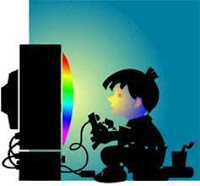The recent tragedies of gun violence have resulted in a renewed interest into the role of violent video games and aggressive, anti-social, and violent behavior. The current view is that many young people who commit violent crimes do so because they play violent video games.
In some ways, this is like saying that the use of suntan lotion increases the likelihood of drowning. In research, this is called a spurious correlation. A spurious correlation consists of two events or variables that have no direct causal connection–such as suntan lotion and drowning.
A spurious correlation is often supported by coincidence, or happens over and over, but is actually caused by an unidentified, third factor. There may be a relationship in a correlation:
- A (violent video game play) causes B (aggression and violence),
- B (aggression and violence) causes A (violent video game play),
- OR
- C (a third factor such as antisocial traits and depression) cause both A and B.
There are three explanations for games and violence:
- The causal view: video game violence exposure has a learning-based causal influence on subsequent serious aggression–A causes B;
- A priori view: individuals with high levels of a priori aggression are subsequently drawn to video game violence–B causes A:
- No relation view: that any correlation between the video game playing and aggression is due to underlying third variables such as depression and anti-social traits–C causes both A and B.
Ferguson (2010) controlled for these three views.
The Causal View: Social-Learning – A (video games) causes B (aggression):
For children with low antisocial traits, media violence exposure was associated with less criminal behavior.
The A Priori View – B (antisocial traits) causes A (choice of violent games and acts):
Antisocial children who are most inclined toward criminal behavior may also be those most likely to select violent media. Additionally, it may be that only the most antisocial children will be affected by media violence exposure leading to aggressive behavior and violent crimes. This is the explanation favored by Ferguson et al. (2008) based on similar findings as well as by Kutner and Olson (2007). This should not be underestimated. More research is needed to understand this, but as Giumetti and Markey (2007) alternatively suggest that, although violent video games are harmless for the vast majority of children, for those with preexisting high antisocial traits, video game violence may exacerbate these traits. More research on this is definitely needed.
The No-Relation View: third variables that predicted serious aggression and violence – C (depression anti-social traits) causes both A (violent aggressive behavior) and B (choosing violent games).
The evidence provided by Ferguson (2010) indicates that playing violent games does not lead to violent aggressive behavior.Instead, there was more evidence for the “No Relation” Hypothesis. That Games did not lead to the aggressive/violent behavior.
Instead, it was evidence suggested that antisocial traits and depression predict violent and aggressive behavior.
When outcomes from the Child Behavior Check List were calculated for effect size, (the strength of the phenomenon), depression and symptoms of pathological aggression were seen as strong effects(.5, .62) as well as for bullying (.32).
- So why do studies of violent video game play show increased aggression?
- Why do we see behaviors such as frustration, anger, anxiety after our children play games?
There may be a other factors at play: competitiveness.
Isolationism and exclusion
- Although games can provide a sort of coping mechanism, but they can also present a distraction for not dealing directly with an issue.
- Conversely, having an enjoyable activity may support the individual in a time of challenge and provide an effective coping mechanism that supports them in conjunction with dealing directly with an issue.
If a child, adult, or young adult already has symptoms of depression, anti-social traits, and are further isolated, this is a recipe for danger. For the individual and perhaps the community. In the words of E.M. Forester, we need to “Only connect!”







